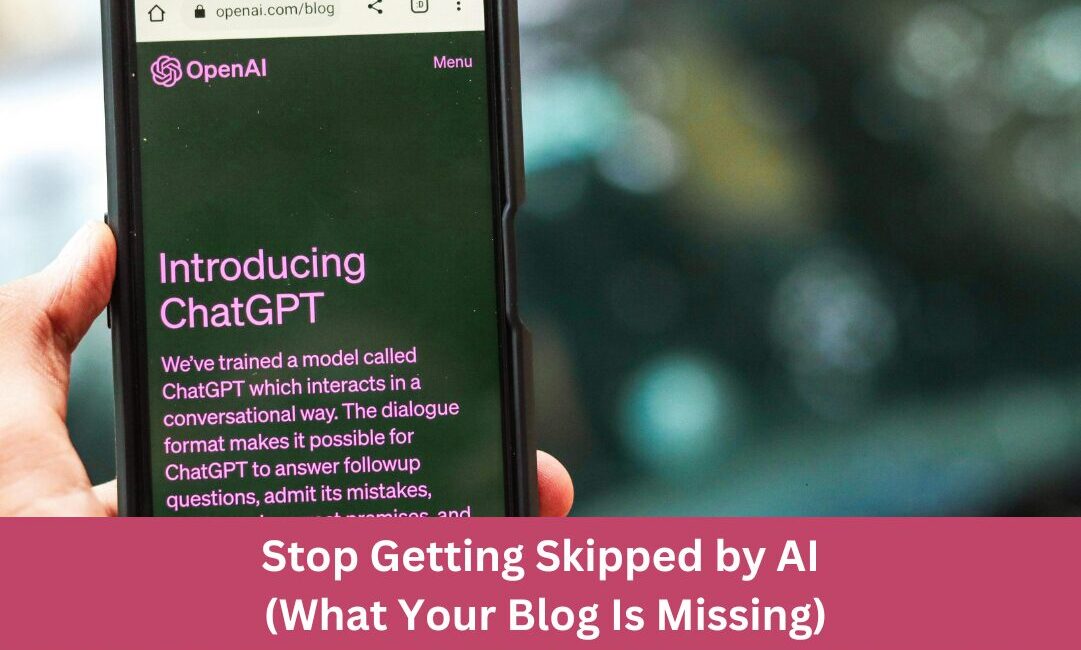Last updated: July 2025
AI Is the New Search Engine
Search is changing.
More people are turning to tools like ChatGPT, Claude, Perplexity, and Gemini instead of Google. And as AI assistants become the first stop for answers, the question becomes:
How do I get my content to show up in those AI-generated answers?
The answer isn’t just SEO anymore. It’s AI Visibility.
And the secret? It starts with your blog.
Blogs: The Unsung Hero of AI Citations
In an analysis of over 500,000 ChatGPT prompts, marketing expert Neil Patel revealed something surprising:
Blogs are the second most-cited source overall, more than news outlets.
A supporting study by Profound found that top blog-style sites like Forbes, Business Insider, and TechRadar appear more frequently in ChatGPT results than traditional news sources like Reuters.
Why Does This Matter?
Getting cited by AI means more than traffic, it means influence.
Unlike Google, where users sift through dozens of links, ChatGPT often delivers a single answer. If your blog is cited, you become the answer. And that can lead to:
- Brand authority
- Direct backlinks from AI-generated responses
- More traffic from secondary sources
- Greater trust with readers
But there’s a catch. ChatGPT Doesn’t Reward Sales Pitches.
AI tools don’t favor the flashiest brands or the most persuasive language.
ChatGPT cites sources that are concise, authoritative, and structured well.
To earn AI visibility, when writing your content be sure to:
- Research well and be factual
- Use clear headers and subheaders
- Include source links and references
- Prioritize structure over storytelling
Think Like an Encyclopedia
ChatGPT favors content that resembles Wikipedia. What does that mean?
- Write in an objective tone
- Define sections
- Incorporate rich internal linking
- Use consistent formatting
Don’t use your blog to promote your business, use it inform and provide information of value to your readers.
Format Your Blog for AI Discovery
If you want to be citied by ChatGPT and other AI engines, follow these formatting best practices:
1. Structure Everything
Formatting isn’t just for readability, it’s for recognition. AI scans for familiar structures that assist with interpreting and summarizing your content accurately. A well-structured layout also inspires users to stay on your website longer, which boosts both SEO and authority.
Stick to these formatting best practices:
- H1 for titles
- H2 for key sections
- H3 for sub-sections
- Bullet points for clarity
2. Cite Reliable Sources
When writing your articles or blogs, be sure to iclude links to:
- Authoritative domains such as .gov, .edu, and well-established media and research institutions. These sources add credibility and context to your points.
- Industry leaders and other respected voices within your niche. Their data and insights not only strengthen your points but also demonstrate that your content is grounded in reputable knowledge.
In addition to improving your content’s value for human readers, linking to outside sources help AI recognize the legitimacy of your content. By aligning your content with trusted sources, you’re signaling to search engines and AI models that your site deserves to be referenced alongside the best.
Example:
“According to Ahrefs, Wikipedia holds 16.3% of ChatGPT citations.”
3. Use Internal Linking
Here is your opportunity to link to relevant posts or resources on your own website. Internal links help AI understand the depth and relevance of your content. They also keep users engaged longer by guiding them through a journey of related topics. Make it a habit to link each new post to at least two or three others on your site. This not only boosts SEO but reinforces your site as an authoritative and one that offers information of value.
Example:
Learn more in our guide on SEO Basics.
4. Add Schema Markup
Schema helps AI and search engines understand your article better by providing structured data about your content. It’s like providing a roadmap to your blog, highlighting exactly what it’s about, who wrote it, when it was published, and how it fits into the bigger picture of your website. This added layer of clarity can increase your chances of being cited in AI summaries and appearing in rich search results. You can use:
- Article schema
- FAQ schema
- Author schema
(Tools like Google’s Structured Data Markup Helper can be used to generate yours.)
5. Write for Depth, Not Just Keywords
Include unique thoughts and examples. A great way to do this is to share your experience. Originality doesn’t mean reinventing the wheel; it means offering perspective, applying insights to real-world scenarios, and backing up claims with verifiable evidence. Share your unique story, lessons from client work, or fresh takes on industry trends. Wherever possible, include data points, charts, or case studies to deepen the authority of your post.
Avoid fluff and keyword stuffing. AI and human readers can easily pick up on blogs stuffed with keywords or overloaded with repetitive phrases. Focus on writing with substance. Write every sentence with purpose, whether it’s clarifying an idea, supporting a point, or guiding the reader to the next step.
AI citations favor content that adds unique value.
What to Avoid
AI models don’t cite:
- Keyword-stuffed content
- Generic articles with no depth
- Overly promotional blogs
- Vague or opinion-heavy pieces with no sources
A Content Checklist for AI Citation
Before you hit publish, be sure to ask yourself the below questions. These aren’t just recommendations; they’re a roadmap for how to make your content worthy of AI recognition. Think of each question as a lens to evaluate whether your blog adds real value, is easily understood by both humans and AI, and positions your website as an encyclopedia-like source for your niche.
- Is this blog structured with headers and sections?
- Are there credible sources cited and linked?
- Is the tone objective and informative?
- Does it offer original insights or data?
- Have I added schema markup?
From Blog to Authority: The Bigger Picture
At Smurk Media, we’ve helped business owners transform their blogs from traffic drivers into AI-referenced authority assets.
We do this by:
- Auditing existing blog structure
- Implementing schema
- Building internal link frameworks
- Creating in-depth, evergreen content libraries
If your blog isn’t earning mentions, traffic, or conversions, let’s fix that → Schedule a call to learn more
Final Thoughts: Write Like a Source
If you want to win in the world of AI search, you can’t just write like a marketer.
You need to write like a source.
That means:
- Clear structure
- Deep expertise
- Factual references
- High readability
ChatGPT doesn’t cite fluff. It cites format, depth, and clarity.
So next time you write a blog, don’t just think SEO.
Think AI Visibility.

Author: Christine Smith, Founder of Smurk Media
Christine is the founder of Smurk Media, a full-service digital marketing agency that helps overwhelmed business owners execute their digital marketing. Christine has become a trusted partner to business owners looking to scale without sacrificing their sanity.


